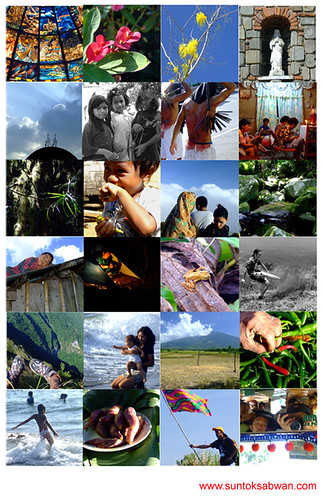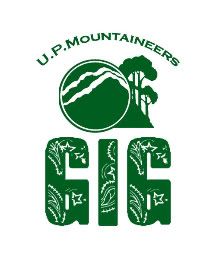skip to main |
skip to sidebar
BAGSIT RIVER
Zambales
20-21 May 2006
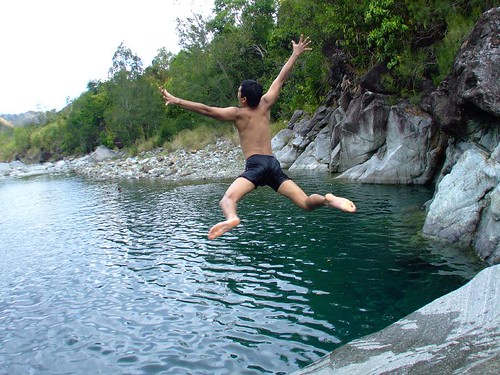
Tubig... Ilog... (Water... River...)
People gravitate towards rivers. It is inevitable. Like giant umbilical cords, these meandering bodies of water fed our earliest communes giving rise to vast cities. It shouldn't come as a surprise that the water used to wet clays that marks the first pages of written history once flowed from a great river.
It may sound like I'm about to launch on a long monologue about the world's great rivers, but relax, I'm not. Last weekend, I went on a slight river trek with some members of UPM and their guests from the Occupational Therapy Department of the Philippine General Hospital.
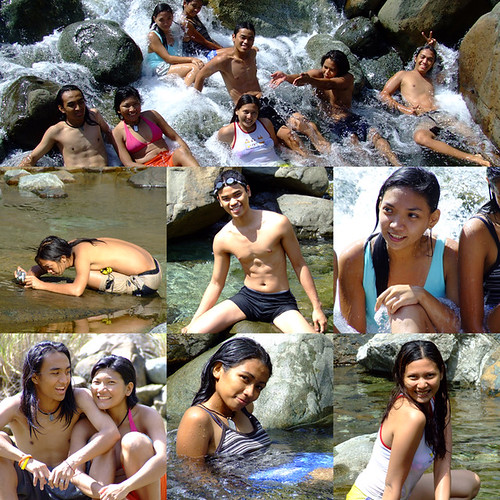
It was to be a low effort trek and being so close to water, it cannot be helped that at every bend splashing good fun was to be encountered.
Following rivers can really be loads of fun. Unlike climbing mountains where water are sourced from specific sites along the way - either bubbling from a spring or flowing from a small tributary, in river trekking all you have to do is stick your face on the ground whenever you feel like it and drink the way water is meant to be drank. Of course, you can always dip your water container if you happen to belong to the genteel class.
I assume you all have the common sense to not follow Pasig River and drink from her banks. Though I have to agree that Pasig River is chock-full of nutrients, drinking it can have disastrous effects on your health. There is a simple way to determine the safety of water in the wilderness: let the most obnoxious person in the group have a sip first and wait for an hour or two. If he or she remains obnoxious after that, then the water is pretty safe.
Normally, you should bring your own water. If you are unsure of the water source and Mr. Obnoxious refuses to drink, then you can treat the water with Puritabs (chlorine tablets - unfortunately, this brand seems to have been phased out in local drugstores), Betadine (pweh!), or use them fancy water purifying camping pumps in tandem with a UV pen (those are cool). For proper procedures, please read over the BMCs found at the UPM website or the documentation which comes with your water purifying device.
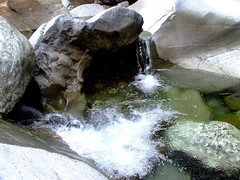 The river is fed by surrounding mountains. We began collecting water for cooking and drinking only after we were sure that there were no human settlements further upstream. I knew it was pretty risky to be drinking untreated water from the wilderness that way but the water was so clean and free from sediments that it was hard to fight the temptation.
The river is fed by surrounding mountains. We began collecting water for cooking and drinking only after we were sure that there were no human settlements further upstream. I knew it was pretty risky to be drinking untreated water from the wilderness that way but the water was so clean and free from sediments that it was hard to fight the temptation.
The water was so clear that you can always see the bottom of the river bed all throughout the trek. Even when it rained, the river remained surprisingly clear.
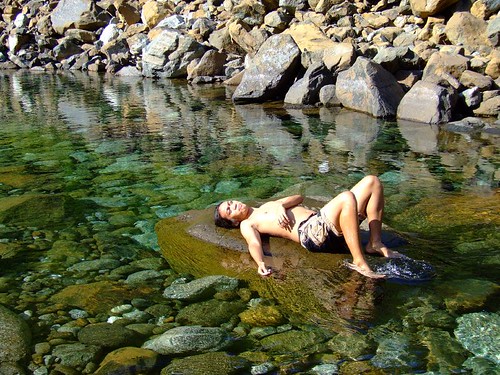
If local wisdom is something to go by, well, they did say that the water upstream was safe to drink.
Puros Bato
Progress was relatively slow as we trekked by the river. The terrain was almost alien. I entertained myself by thinking I was an explorer in Mars as I hopped from one boulder to the next. Of course, in Mars the rocks would have been sharper since there isn't water to shape rocks the way it does here on Earth (I don't know why I'm telling you this, it's my fantasy in the first place and I don't have to show the plausibility of my own pantasya).
Though at a very gentle incline, boulder strewn terrains are the most dangerous terrain in my opinion. Piled up boulders can be pretty slippery, notoriously unstable and in places where erosion had broken it, can be pretty sharp.
To make matters worse, constantly hopping from one boulder to the next for hours can induce a trancelike state. Sometimes you find yourself concentrating on plotting your route without thinking where you are placing your feet. Sometimes you will be focusing on where to lay your foot that you will fail to see that you are heading towards a precarious set of boulders with deep dangerous spaces.
Most injuries I have come across in the wilderness usually involved boulders. Limbs can get wedged in the spaces and with the aid of gravity either pull a muscle or tendon, dislocate a joint, or worse still break a tibia.
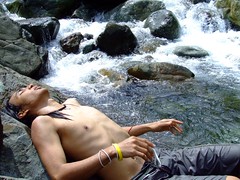 I have made mention a number of times in this blog regarding a reddish alga that when dry has no notable quality but when wetted becomes as slippery as ice. On this trek, we had to cross a field of boulders covered in these while it began to rain. To understand how slippery it was, we all knew the nature of this algae and were very cautious in our footing but still a number of us fell and came out of that field with badly bruised knees. On another section of the trek, I myself had my legs pulled from under me as I gingerly shifted my weight across a flat slab of rock covered in red algae.
I have made mention a number of times in this blog regarding a reddish alga that when dry has no notable quality but when wetted becomes as slippery as ice. On this trek, we had to cross a field of boulders covered in these while it began to rain. To understand how slippery it was, we all knew the nature of this algae and were very cautious in our footing but still a number of us fell and came out of that field with badly bruised knees. On another section of the trek, I myself had my legs pulled from under me as I gingerly shifted my weight across a flat slab of rock covered in red algae.
Litratista's Lament
Water and digital cameras don't mix. It was hard negotiating thigh deep water knowing your digital camera is sitting vulnerable inside your belt pack inches from the water's surface.
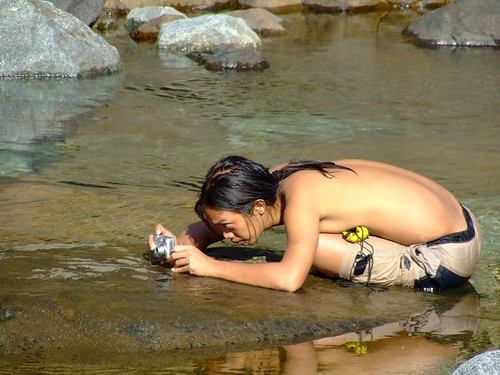
What would take a few seconds took minutes as each measured step is test and retested to ensure a secured footing while water rushed by making you giddy and somewhat disoriented. Every boulder that stuck out of the water's surface is a godsend and I didn't hesitate to grab onto anything to provide that added stability - even if it meant grabbing onto and shoving an already off-balanced companion just to secure myself. Better their digital camera than my digital camera I'd always say.
As a personal rule, I always bring along where I'd store my camera a pair of plastic bags and a thicker resealable bag just in case it rains or if we had to cross waist deep water. When that happens, the camera gets wrapped up in plastic and shoved into a dry bag. This in turn will be shoved into my water resistant back pack. This method has so far gained my confidence. I'm not so sure of it though if ever the bag becomes completely submerged - which does happen.
Packing Light
If there is anything I've learned from my Bicol trip, it would be the virtue of packing light. For this trip, I've foregone my flash unit and backup camera. I was meaning to bring a reflector and experiment with outdoor portraiture but decided against it at the last minute.
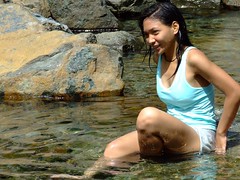
I've brought only the essentials: my Finepix camera, a tripod, skylight filter, circular polarizer, my Opteka 0.45x add-on lens and an extra set of batteries. All these except for the tripod went inside a padded belt bag I bought at the mall for 400 pesos.
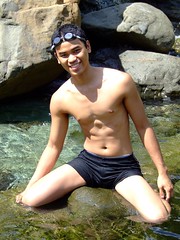
These make up my basic outdoor photo gear. If I must bring more, I'd want to bring along neutral density filters and other creative filters for landscape photography - in particular those split neutral density filters to prevent the sky from burning out. It has also come to my attention that certain bag liners do come with a silver lining which can double as a nice reflector for portraiture. Bringing photographic equipment that can double for another purpose is ideal for trekking where weight is a major consideration.
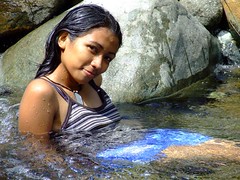
Now, if I were to be allowed a certain amount of decadence, then I'd want a Hassie with a nice prime 17mm lens if you please. Seriously, I wouldn't mind the weight.
Quiet Water Runs Deep
After hopping from one boulder to another for about two and a half hours, we encountered the deep pool locals call Tutan. I don't know if the people we've spoken to were being serious about this because "Tutan" is only a syllable away from the vernacular "Kantutan" which means to have sex. Needless to say, the introduction of the site to us resulted in sniggers among the less mature members of the group.
By the time I arrived at the pool's site, members of our group were already screaming at the top of their lungs as they jumped off boulders and into the crystal clear water of Tutan.
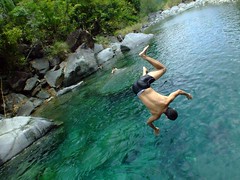
The pool was surprisingly deep - about 15 feet deep at the center. Huge boulders the size of small buses lined the pool with only their top most surface showing. Blocking the cascades upstream is a large boulder wedged between smaller rocks beneath the surface. It makes a perfect platform to dive into the pool or sunbathe.
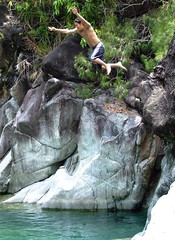 A rock formation on one side provided a tiered platform for diving where the highest point is about 20 feet from the surface of the water. A good and secured push is required to clear outcrops above and below the surface of the water. Looking down from such heights was exhilarating - especially when you're psyching yourself for the jump.
A rock formation on one side provided a tiered platform for diving where the highest point is about 20 feet from the surface of the water. A good and secured push is required to clear outcrops above and below the surface of the water. Looking down from such heights was exhilarating - especially when you're psyching yourself for the jump.
Some of the platforms are located in such a way that backtracking is more dangerous than jumping. It is a great motivator for acrophobics to finally jump if you ask me.
Exploring the depths of the pool revealed thumb-size silver fishes and pinky-size shrimps swimming about in schools. Some of us contented ourselves observing these perky creatures as they dart about submerged boulders.
It might come as a surprise to some but snorkels and goggles are standard gear for some mountaineers. As for me, I have a special place in my bag for goggles. Now, to make room for flippers...
Watermark
If ever you've gone out to look for a new home, you've probably been advised by relatives or friends to check the back of the sink or the wall behind the refrigerator for watermarks. If present, these show how high flood water had risen in the past. Generally, you wouldn't want a house that displays these marks.
On this trek, I couldn't help but notice what looked like watermarks and scars that can only be created by a raging river at levels far above the top of my head. For one, driftwood is pretty unmistakable and seeing large chunks of these wedged between boulders 12 feet above where we were walking was not really that reassuring.
I haven't witnessed a flash flood so I cannot help it if my visualization of what can happen is a composite of footages from the Asian Tsunami and scenes from the movie The Day After Tomorrow. Adding to my anxiety was the heavy rain that fell when we resumed our upstream trek from Tutan.
For all we know, there could be a major downpour upstream and in the mountains that drained into the river. For all we know, a raging body of water could be heading our way just around the bend. I kept myself pretty much preoccupied looking out at front and plotting escape routes through the maze of boulders just in case the unthinkable does happen.
I noticed that the sides of the gulley were pretty steep; and were pretty much vertical for about 5 to 8 meters in some stretches. Looking at it, I can imagine the banks of the raging river cutting through the gully and etching these deep vertical walls. I imagined huge boulders being washed out from the side of the mountain and after losing its grip on the soil, tumble like a rubber ball into the river.
Perhaps it was a shared anxiety, because as we progressed and as the level of the river rose, I noticed our group trekking ever closer to the slopes of the gulley and away from where the river rushed.
Tulak Palayo sa Kampo
After about two hours from Tutan we reached a bend in the river with a course sand bank at the inner elbow and a line of sharp rocks on the other. We have reached the campsite. Though camping at the sandy bank was tempting being so conveniently close to the water, common sense saw us pitching our tents way up beyond the banks.
The water was again surprisingly deep - though not as deep as Tutan. Just around the bend was a cascade which provided a constant yet soothing noise at the campsite.
Just before dark, I found myself exploring further up the river by myself. I had this inkling that I might find an entrance to an underground stream over yonder where I made out a slight depression on the side of a steep incline. Though the river and its flow were obvious, there are streams flowing into the river from the slopes straddling it for which their sources are unbeknownst to us.
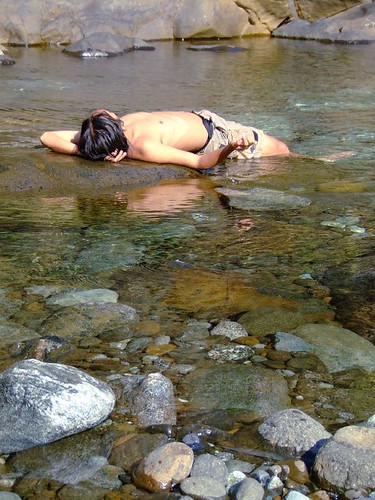
When I found myself face to face with my indentation, what I found was just that. But at the center of the unusually clear depression was a sandy patch with concentric white bands at the edge. That made me wonder: do we have quicksand in the Philippines? I inched closer towards the banded edge and decided to dip my toes into it and see. After making sure of my footing, I gingerly dipped my toe in.
It was a complete waste of time. It was just that: a patch of sand. Walking back to camp, I vowed to trace that river to its source one day.
Saan Yun?
To get there, join a responsible and MFPI registered mountaineering organization, internalize your BMCs (Basic Mountaineering Course) and learn by heart your LNT (Leave No Trace policy for climbers and trekkers).
Once you've got that out of the way, get a map and explore!
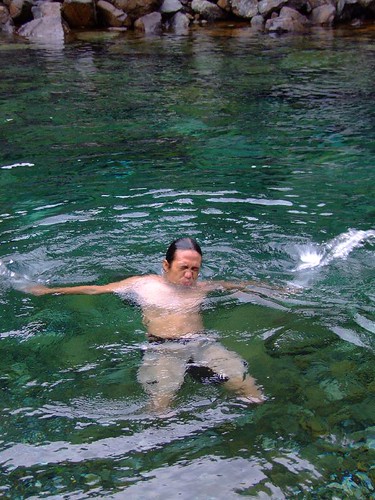
Too many people have asked me not to divulge the location of the site or provide instructions on how to get there. If you've been following what I've written in this blog, you are aware of my frustrations with irresponsible backpackers. They will enter the wilderness without a care in the world for the trash that they leave behind. Worse, they would etch rocks and trees that had been there even before the birth of their grandparents with their meaningless nicknames and stupid personal phrases to live by like: "Punks not Ded" or "Jhun loves Jhane".
Go see my Pico de Loro entries and take a look at the mindless markings on the rock formation. You will come to understand the reason why many mountaineers assign to themselves that role as wards to these places of tranquility and beauty.
If it was very hard to get at, then I wouldn't hesitate to publish an itinerary. Usually, the fools I'm referring to here don't have the resources both monetary and physical to get there anyway. But this hideaway is relatively easy to get at hence our hesitation. We don't want another disaster like that of Pico de Loro, Famy, and Majayjay where every Jhun, Jhane and Jhenny have left their indelible mark on every rock, tree and cranny.
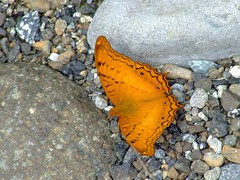
I'm not denying anyone their right to enjoy what is also theirs. It is not exclusively mine to begin with. All I'm saying is don't ask me for directions to Bagsit River.
(Something that is submitted late, Pahabol. Root is habol - or chase)
The hardest thing about keeping a blog is finding the time to actually sit down and write. The next hardest thing is finding something to write about.
It is inevitable that the first few entries would turn out to be an outpouring of sorts. Like a typhoon, it is hard to understand where all the water and wind could have come from and no way of telling when it will stop. But the calm never fails to arrive.
So before the calm arrives, I say go to where the beer flows, and go quick while it hasn't run out!
There are a few entries that I should have posted ummm... about two months ago but was not able to because I haven't completed the write ups just yet. It is pretty much useless to post it in their corresponding dates because it will appear at the bottom of this page and most likely people would have lost interest half-way down before actually seeing them. On the other hand, it is pretty much deceitful to post it at today's date because...because...that would be lying! So to appease my sensibilities, I came up with this: I'll post to link to my entries dated a month or two months back.
Here is a post on my write-up and pictures of my Mt. Pulag Climb last February titled, Pulag Revisited. Either click on the hyperlinks or click on the images below.
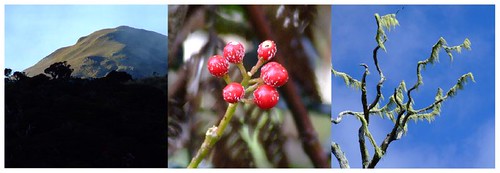
Here is another post about my Pico de Loro climb on the same month titled, Pico Redux.
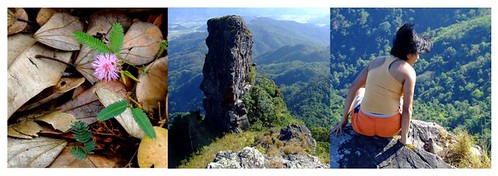
If you haven't noticed it, I have links on the bottom right column linking to all posts related to hiking and mountaineering. I've also made available the section linking to some of the short stories I've written. Hopefully I can come up with more. I have a number of sketches so lack of material is not really a problem. The problem is time oh precious time.
Mt. Isarog and Mt. Iriga
Camarines Sur
April 11-16, 2006
This quaint Holy Week break was spent in the Bicol Region. It started with a rushed Tuesday afternoon and ended with a very lethargic Sunday morning.
What can I say about Bicol? It is such a clean, fresh and relaxed place to go to. We visited Pili, Isarog, Iriga and Naga. We went through some other towns but the names escaped me.
The people are proud of their identity. You ask them a question in Pilipino and they will answer back in their local dialect. We learned that we must be specific in saying that we can't understand for them to speak Pilipino. And when you hear them speak Filipino you'd wonder what the fuss was all about because they speak better Filipino than your mother.
Interestingly, if you tell an Ilonggo in Bacolod City that you can't understand them, they will reply to your Pilipino in English. I guess the provinces are reluctant to adopt the Pambansang Wika. Come to think of it, Pilipino is mostly Tagalog which probably spurred this resentment. However resentful people might be, as long as they speak it then it is ok.
But whoa! We've encountered elder Bicolanos who spoke a dearth of Pilipino and showed no sign of comprehending our babbling. It is good that Pilipino is compulsory in primary school.
The towns we visited had the same pattern as most towns in the Philippines: look for the church and you will find the town center, local government offices and most of the more important establishments like banks, market, restaurants and of course, parks and amphitheatres.
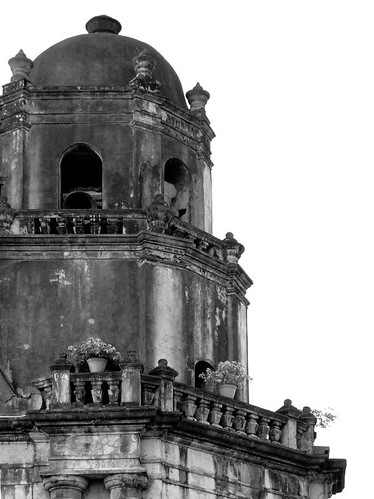
I was particularly impressed with Naga City and Iriga City. These cities show the mark of good urban planning. They have large public open spaces in what seem to be the center of the City and from this, large wide roads radiate. It is easy to find anything and public utility vehicles are accessible without being a nuisance to traffic.
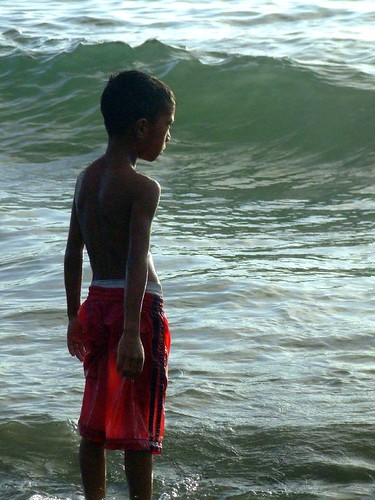
Hit the beach and you will find the water surprisingly warm. I was tempted to go for a swim at night but remembered that huge sharks love warm waters - I think this was from a complex I developed after watching too much Animal Planet.
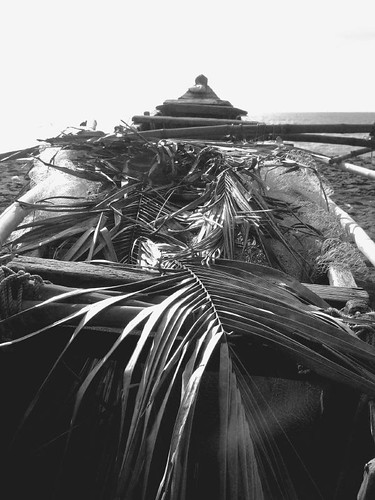
Food is excitingly cheap! For 30 pesos, you get a nice helping of ulam and a huge scoop of rice to go with it. Hit the markets for great cheap food. I thoroughly enjoyed this particular dish made of clams sautéed in coconut milk and chili. The laing offered were equally exquisite. I learned from this trip that you can cook laing in as many ways as there are cooks to cook it. Suffice to say, no two establishments in Bicol offer the same tasting laing.
If ever you find yourself in Naga City, look for Ice Blinkers. They make the powder-iciest Halo-Halo ever! It is one of the best ways to spend 60 pesos in this world.
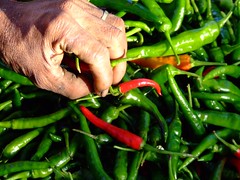 There is only one complaint from this weary traveler: it seems that everything you can put in your mouth is spiced with chili in that Region (except for the Halo-Halo of course, but I did detect a faint zing to it. Hmmm...).
There is only one complaint from this weary traveler: it seems that everything you can put in your mouth is spiced with chili in that Region (except for the Halo-Halo of course, but I did detect a faint zing to it. Hmmm...).
Bicol Region is a rolling valley huddled by Titans! Over the horizon you will see towering volcanoes from all directions. Some are active and some bear the masochistic scars of a violent past where whole mountain sides seem to have been blown off. It is here that the southern tip of Luzon tapers off and the Visayas begins.
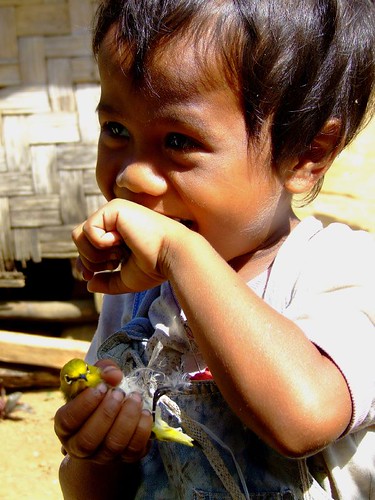
Many picture opportunities await a photography enthusiast in Bicol. The food is colorful, tropical flowers abound, and there are dormant and active volcanoes for the more vigorous camera wielding bunch.
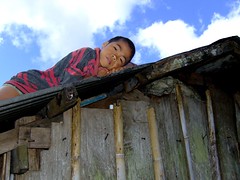 I was dying to climb and take pictures in and around Mayon and of Mayon. But looking at its beautiful conical shape capped by grey smoke, one cannot help but ponder about ones safety and future. Sure, I have life insurance but still, I have all the reasons in the world to not want to be vaporized by super hot lava or be broiled to perfection by superheated gas. Even something as mundane as asphyxiation is close to reality in the slopes of an agitated volcano.
I was dying to climb and take pictures in and around Mayon and of Mayon. But looking at its beautiful conical shape capped by grey smoke, one cannot help but ponder about ones safety and future. Sure, I have life insurance but still, I have all the reasons in the world to not want to be vaporized by super hot lava or be broiled to perfection by superheated gas. Even something as mundane as asphyxiation is close to reality in the slopes of an agitated volcano.
Restrictions are in place and a six kilometer no go zone around the base of Mayon is in effect. Such things are not put in place on a whim. It is good to pay heed to signs lest the last 10 minutes of your life ends up in a reality TV show.
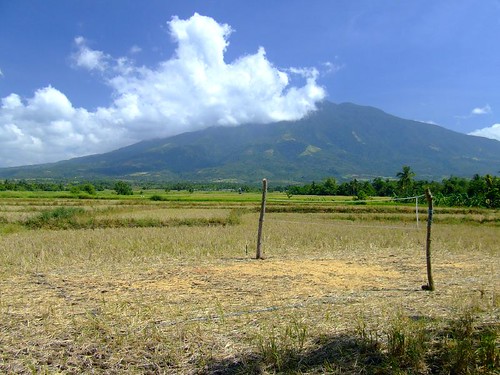
The reason for our Bicol trip was to climb Mt. Isarog in the province of Camarines Sur. At 1,966 meters above sea level, I was expecting an awesome view of the inactive volcano's crater and the valley floor below. But as fate would have it, Isarog was whimsical that morning and would not reveal her girth to us from her summit. Heavy clouds blanketed the summit and we did not even get a glimpse of the surrounding ridges leading up to where we stood.
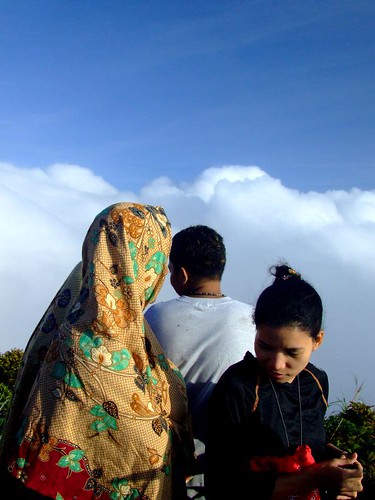
Though the summit is a great place to be, and for which many single-mindedly affix their imagined target when climbing, it is not the whole mountain - the summit is not Isarog.
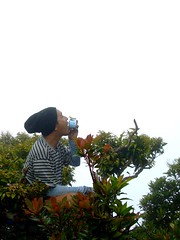
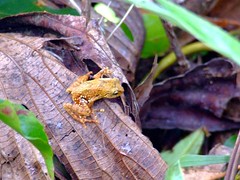
Whether perhaps I will still be thinking this same way if the summit offered a view that kicks you in the gut with beauty, I don't know. But I have always tried to see a mountain in as many points of view as I could.
Documenting more and seeing more would have been easier if I was a notch more fit and had carried a much lighter pack. Summing up what happened to me in a word: destroyed - I was destroyed by that mountain. Exhaustion and pain blinded me, that is why I could not manage that much shots of the trek.
We started the trek from Brgy. Consocep, our jump-off point. We took the Patag-patag trail which was explained to us as not being the traditional route up the mountain by our guide and climb organizer, Alex of Kadlagan Outdoor.
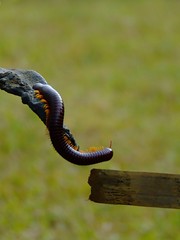
During the briefing, he explained that the trail is relatively new and that we will be passing through pristine areas. He asked everyone to be light on their feet and be careful with the thick mosses that grow on the branches along the trail.
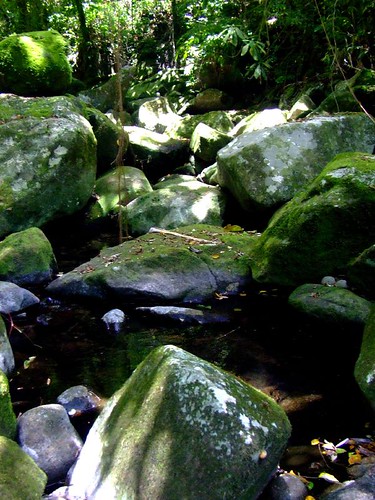
The trail was called Patag-patag because according to Alex, there should be 2 portions of the climb where the slope will even out (patag meaning even or horizontal). I don't know what he was talking about but the whole thing from start to finish felt like an assault.
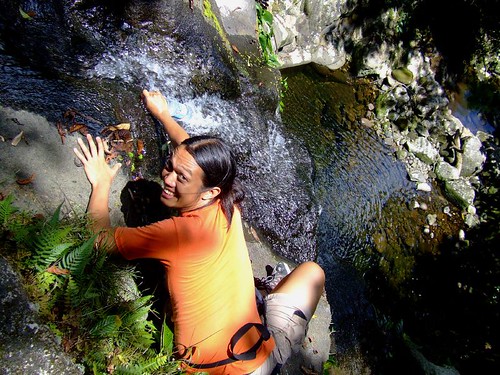
If you plan to climb that trail, the way the volcanic slope is shaped will guarantee a steady ascent up until you reach the summit. Climb light and favor ridge runner bags over tall packs. The trail is tight and Isarog will require you to go low, get a leg up high, skip and jump and what have you.
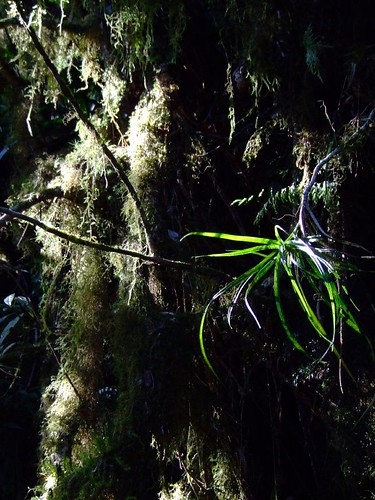
Somewhere near the campsite, the trail will meander around fallen trees and you will need to parry and weave around thick moss laden branches. If you love nature, you will cringe at the snap and crack that will follow your wake through the mossy forest if you insist on a tall pack.
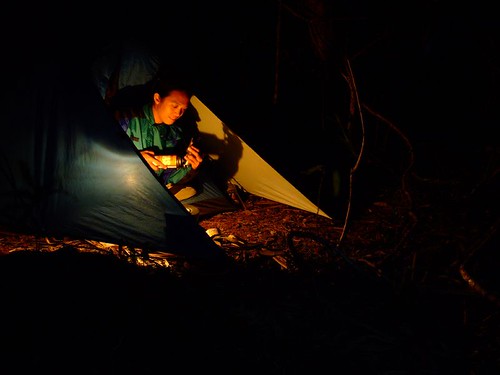
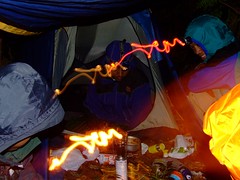
After Isarog, four of us from a group of about twenty five decided that we haven't had enough of mountains. So shunning white sand island beaches and placid lakes, the four of us took our heavy bags, bid farewell to our transient companions and made out way to Mt. Iriga.
Mt. Iriga was a disaster waiting to happen. Looking at the breadth and elevation of the 1,470m volcano and aiming to climb it in four hours without backpacks, under a blistering sun with no water source along the way, was being a touch too optimistic.
Mt. Iriga is very accessible. Just catch a ride to Iriga City and contract a tricycle to take you around. The jump-off is about an hour on foot from the city center.
Just a word for climbers, everyone who wishes to climb Mt. Iriga is now required to secure a permit from Brgy. San Roque, Iriga City. The military maintains an outpost leading to the trail and they will not let climbers in without a permit. A recent incident which saw a large portion of the mountain burnt because of local activities had ticked local officials. Now, in an effort to preserve the mountain for ecotourism, they have made access to it relatively limited. All fine with me really, as long as it keeps the vandals, litterbugs and arsons out.
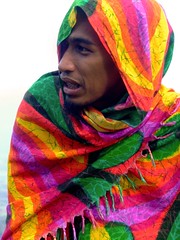 I don't recommend haggling with the military manning the check points. They seem uppity and suspicious of oddly dressed climbers. If you have Arab or Indian features, don't take a chance, get the damn permit. One of our companions who remotely looked Indian was being eyed and scrutinized more intently by the officers than us.
I don't recommend haggling with the military manning the check points. They seem uppity and suspicious of oddly dressed climbers. If you have Arab or Indian features, don't take a chance, get the damn permit. One of our companions who remotely looked Indian was being eyed and scrutinized more intently by the officers than us.
Mt. Iriga showed two ironic and poignant scenarios in climbing. One is, you can see where you want to go, but looking at it from where you are is disheartening because you can actually feel the heat of the sun draining your energy every step of the way and yet, the point where you want to go doesn't seem any closer than it was half an hour ago.
The other is that you can't see where you are going as you weave through and get lacerated by two storey high cogon, and the seemingly never ending ascent drains your morale and strength. When I was a kid, I had a pumped up imagination and one of the things I was thoroughly engrossed about was how it was like to be a bug in the middle of our garden amidst a never ending forest of Bermuda grass. Little did I know that in my adult life I would find out the hard way.
While the sun scorched us, the cogon hindered our ascent as lines of cut or broken cogon stems stood like phalanxes stabbing our limbs and body. One of my biggest fear was that of being impaled if I slipped and landed squarely on a fat stem. My next concern was being struck in the eye and blinded by them.
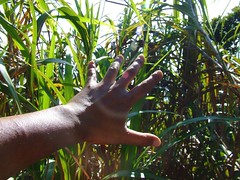
Cogon is simply grass - but on some mean steroids I'd think. We've encountered ones about two stories high and resembled a bamboo more than the grass that they are. They have leaves three inches wide and sharp enough to bite and cut your skin like a razor. Worst, they have this fur that sticks to your skin and itches. Depending on the stalk's condition, the fur would either rub off like dust or actually dig in like tiny thorns and draw some blood from you.

Apart from all the hardships that this mountain had meted us, the view from her top most ridge was exhilarating enough for her to be forgiven twice over. It is at her peak that you will be told by sight the story of Camarines Sur. You can trace with your eyes the boundaries of the valleys as they lap at the hem of Mt. Isarog, Mt. Mayon and Mt. Malinao. You will see low ridges boxing in this fertile valley and learn of the origins of the lakes. At this vantage point, you will understand the relationship of humans with nature and how their pattern of settlement is the same from lake to lake, from river to river.
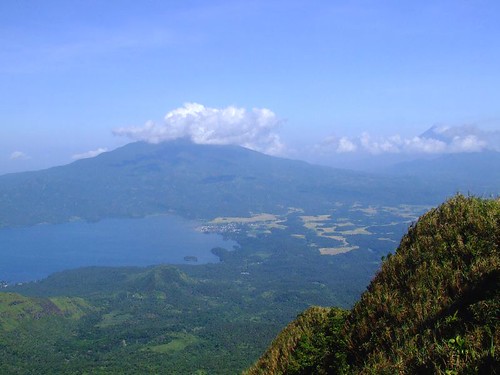
Descending was uneventful except that it was the only time that I discovered that the summit ridge was sprinkled with pitcher plants, and I've learned that a grown man about my size can down three huge buko (coconut) all by himself. That last one was a surprising and enjoyable revelation.
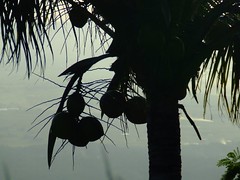
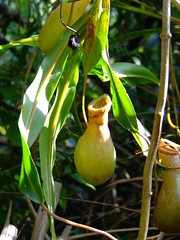
When we reached the military check point it was dusk (we went down the same trail we went up). We had a little chit-chat with the residents and soon made our way to the only place where we can wash up: the irrigation channel.
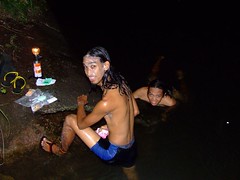 It looked like an estero to me but I was appeased by the sight of neat looking locals dive bombing from the side of the road. Besides, I couldn't spot trash and the water didn't smell funny. So like dressed chickens we crossed our fingers and took a dip hoping we weren't bathing in another town's runoff water. If it's any assurance, the water was clear even in the dying light for us to see our knees in chest deep running water.
It looked like an estero to me but I was appeased by the sight of neat looking locals dive bombing from the side of the road. Besides, I couldn't spot trash and the water didn't smell funny. So like dressed chickens we crossed our fingers and took a dip hoping we weren't bathing in another town's runoff water. If it's any assurance, the water was clear even in the dying light for us to see our knees in chest deep running water.
Normally, local residents would welcome mountaineers into their bathrooms to wash up - sometimes for free and sometimes for a small fee. The community there we surmised however, had no running water as we saw no tap in one of the bathrooms we entered. Plus we saw people carrying water containers across the road. Courtesy dictates that we shouldn't have to give people reason to say no.
One word of advice for travelers though: if you are not sure if you are done with your wandering, never go near a terminal where a bus going home can be chanced upon. The pain in your knees and thighs, the soreness you have been feeling in your back, the scratches and what have you will very much make that bus seem like the best place on the planet. It was this mistake that we saw ourselves back in Manila when we should still be finding our way across the base of Mt. Mayon in Legaspi.
ITINERARY
Mt. Isarog
Patag-Patag Trail
Brgy. Consocep, Ocampo, Camarines Sur
April 13
Day 1
5:00 am ETA, CBD Bus Terminal Naga City from Manila
6:00 am Registration of participants
7:00 am ETD, to Brgy. Consocep
8:30 am Brgy. Consocep, Jump Off point,short briefing
9:00 am Start ascend to campsite 8-9 hrs climb
12:00 nn Lunch along trail (packed lunch)
4:00 pm ETA, Campsite, set csmp, prepare dinner, socials
10:00 pm Lights Off
April 14
Day 2
4:00 am Wake Up Call, Prepare Breakfast/
prepare for assault
5:30 am Start Summit Assault
7:00 am Summit, take pictures...
8:00 am Back to Campsite
9:00 am Campsite, Breakcamp, Prepare for descend
12:00 nn Lunch along trail (packed lunch)
4:00 pm ETA, Jump Off Point
4:30 pm ETD to Naga City
6:00 pm Naaga City- Side trip na!!!
Water load 3-4L
Bus terminal to Naga City, Bicol is in Cubao, bus fair is
P500-P600 air-conditioned.
Time travel- 8-10 hrs from Cubao to Naga
IT by Alex (Kadlagan)


 The river is fed by surrounding mountains. We began collecting water for cooking and drinking only after we were sure that there were no human settlements further upstream. I knew it was pretty risky to be drinking untreated water from the wilderness that way but the water was so clean and free from sediments that it was hard to fight the temptation.
The river is fed by surrounding mountains. We began collecting water for cooking and drinking only after we were sure that there were no human settlements further upstream. I knew it was pretty risky to be drinking untreated water from the wilderness that way but the water was so clean and free from sediments that it was hard to fight the temptation.
 I have made mention a number of times in this blog regarding a reddish alga that when dry has no notable quality but when wetted becomes as slippery as ice. On this trek, we had to cross a field of boulders covered in these while it began to rain. To understand how slippery it was, we all knew the nature of this algae and were very cautious in our footing but still a number of us fell and came out of that field with badly bruised knees. On another section of the trek, I myself had my legs pulled from under me as I gingerly shifted my weight across a flat slab of rock covered in red algae.
I have made mention a number of times in this blog regarding a reddish alga that when dry has no notable quality but when wetted becomes as slippery as ice. On this trek, we had to cross a field of boulders covered in these while it began to rain. To understand how slippery it was, we all knew the nature of this algae and were very cautious in our footing but still a number of us fell and came out of that field with badly bruised knees. On another section of the trek, I myself had my legs pulled from under me as I gingerly shifted my weight across a flat slab of rock covered in red algae.




 A rock formation on one side provided a tiered platform for diving where the highest point is about 20 feet from the surface of the water. A good and secured push is required to clear outcrops above and below the surface of the water. Looking down from such heights was exhilarating - especially when you're psyching yourself for the jump.
A rock formation on one side provided a tiered platform for diving where the highest point is about 20 feet from the surface of the water. A good and secured push is required to clear outcrops above and below the surface of the water. Looking down from such heights was exhilarating - especially when you're psyching yourself for the jump.




